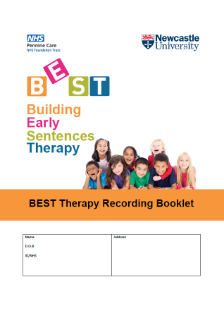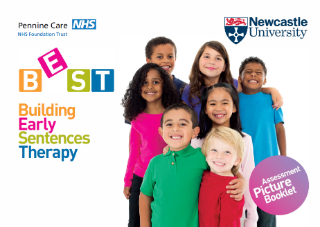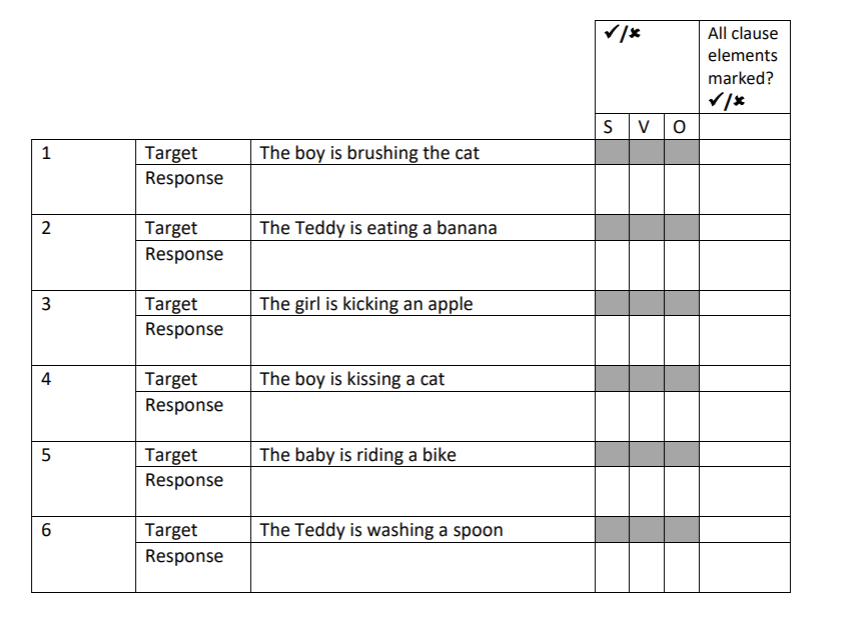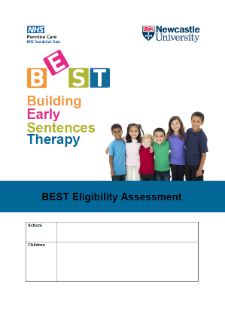Assessment
BEST assessments are used before, during, and following intervention to identify eligible children and measure changes in their language ability over time. Here you will find links to assessment resources, and guidance on delivering and scoring assessments. For more detailed guidance please see the BEST Assessment Record Booklet
 BEST assessment record book (pdf)
BEST assessment record book (pdf)
Except for the BEST Eligibility Assessment, all BEST assessments follow the same format. Using the BEST Picture book, show the child one picture at a time and say “Tell me what’s happening”. Record the child’s response (if any) on their assessment recording form. Here it is important to note that it is not necessary to try to get full responses out of the children, or repair or remodel any of their answers. The aim of the assessments is to capture the child’s unsupported expressive language ability. Refer to the scoring section below for how to score this assessment.
1. BEST Eligibility Assessment
Who can deliver the eligibility assessment?
Speech and Language Therapists (SLTs)
BEST is designed for children with significant language difficulties or disorder; therefore, it is important that an SLT administers the eligibility assessment to ensure that BEST is appropriate and to identify and support additional speech, language, communication and developmental needs. Failure to involve SLT services in this process may result in missed diagnoses and lack of specialist support for vulnerable children.
What does it involve?
Firstly, children are observed playing with a selection of toys to assess their play and attention skills. Children must demonstrate the ability to engage in joint, shared attention with an adult by looking from the toy and back to the adult. Children must also demonstrate an ability to use the toys symbolically (e.g. pretending to brush Teddy’s hair) and imitate the adult playing with the toys.
Children are then shown some pictures from the BEST picture book and are prompted to tell the adult what is happening in them (e.g. "the girl is sitting"). Their responses are then written down and scored. Children who receive a low enough score in this part of the assessment are eligible for BEST, provided they have demonstrated sufficient play and attention skills.
Resources
2. Baseline Assessment
Who can deliver the baseline assessment?
Speech and Language Therapists
This assessment can be administered directly following the Eligibility assessment, if the SLT determined that BEST is appropriate for the child. It is used to measure children's expressive language ability before receiving the intervention.
Resources
 BEST assessment record book (pdf)
BEST assessment record book (pdf)
 BEST Assessment Pictures (pdf)
BEST Assessment Pictures (pdf)
3. BEST Assessment 1
Who can deliver the first assessment?
Speech and Language Therapists or school staff (teachers, teaching assistants, SENCOs)
This is a ‘decision point’ assessment which can be delivered after a child has completed 8 BEST sessions. The purpose of the assessment is to track and monitor children’s progress. If a child shows significant improvement in this assessment (i.e. achieves a score of above 85% in content and morphology) you have the option of discontinuing treatment. You may wish to consider this if you have other children waiting to start in a BEST group and you want to free up space in a group. However, if you have sufficient resources and children are continuing to enjoy BEST sessions, feel free to continue treatment.
Resources
Resources can be found in the Baseline Assessment section.
4. BEST Assessment 2
Who can deliver the second assessment?
Speech and Language Therapists or school staff (teachers, teaching assistants, SENCOs)
This is the second ‘decision point’ assessment, to be completed after the child has completed 12 BEST sessions. As with BEST assessment 1 the aim is to track the child’s progress. If a child shows significant improvement in this assessment (i.e. achieves a score of above 85% in content and morphology), you have the option of discontinuing treatment or you can let the child complete the final four sessions if you feel they will continue to benefit.
Resources
Resources can be found in the Baseline Assessment section.
5. BEST Outcome Assessment
Who can deliver the outcome assessment?
Ideally the outcome assessment should be delivered by a Speech and Language Therapist but can be administered by school staff if necessary. If the assessment is delivered by schools, it is important to discuss the results with the child’s therapist.
This assessment is completed immediately or soon after the child completes their final BEST session. The aim is to measure the child’s expressive language ability after treatment and scores can be compared to the baseline assessment to see what progress they have made.
Resources
Resources can be found in the Baseline Assessment section.
6. Follow Up Assessment
Who can deliver the follow up assessment?
Speech and Language Therapists or school staff (teachers, teaching assistants, SENCOs)
This is an optional assessment to see if children have continued to improve following the intervention. It is administered 6 weeks after the outcome assessment has been completed. During those six weeks parents may wish to continue going through the homework booklets to consolidate their children’s learning.
What happens next?
After a child has completed all the BEST sessions and assessments, it is important to discuss their progress with caregivers and Speech and Language Therapy Services. Where children have made good progress with their expressive language skills it may still be necessary to consider and support other needs such as understanding language, speech and social development.
For children who continue to have difficulties producing sentences do not repeat the BEST program. If children have not benefited from BEST it is very unlikely that they will benefit from further sessions. These children will likely require further, specialist support from Speech and Language Therapists or other professionals.
Resources
Resources can be found in the Baseline Assessment section.
7. Scoring
All assessments are scored in the same way. Scoring is divided into two parts, content and morphology.
Content words are nouns and verbs (e.g., man, apple, boy, walk). Morphology includes function words such as ‘a’ ‘the’ and ‘is’, prepositions such as ‘on’ ‘to’ and ‘into’ as well as parts of words such as the ‘ing’ part of the verb (e.g., runn-ing)

The full target sentence is provided for each item (i.e., the words we would expect someone to use to describe that picture). Refer to the ‘target’ column to decide if a correct or acceptable word has been spoken by the child. Acceptable alternatives for a target word are provided in brackets immediately following the target. For example, Teddy (bear); either word is acceptable and scores one point. If the word is not listed on the form, it is likely incorrect. A complete list of acceptable alternative words can be found on the record form itself
- Tick if the target word is included in the child’s spoken response and put a cross where it is absent.
- Off-topic and irrelevant spoken utterances are scored as incorrect (e.g., comments about that picture that do not describe what is happening such as “that’s funny”).
- Local dialectal variations are scored as correct (e.g., “babby” for baby).
- If a child incorrectly substitutes a word this is marked as incorrect (e.g., ‘boy’ for ‘man’ would be marked as incorrect. In the pictures, men are depicted with beards to distinguish them from boys)
- Each correct content word or morpheme is given one point
- Count the number of ticks in each a row and calculate the percentage correct by adding up all the points the child received and divide this by the total number of possible points. Then times this number by 100.
Scoring example
In the baseline assessment a child receives a score of 25 out of a possible 48 for content words, and 39 from a possible 67 for morphology.
Content words percentage correct: 25 divided by 48 is 0.52. 0.52 times 100 is 52%
Morphology percentage correct: 39 divided by 67 is 0.58. 0.58 times 100 is 58%

